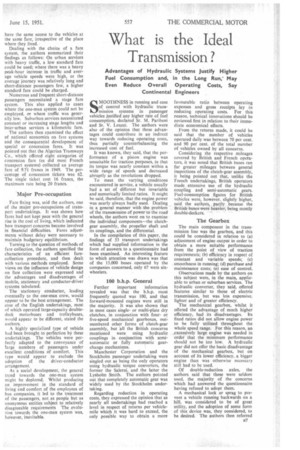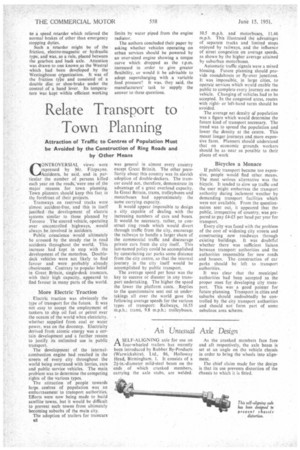What is the Ideal
Page 41

Page 42

If you've noticed an error in this article please click here to report it so we can fix it.
Transmission?
Advantages of Hydraulic Systems Justify Higher Fuel Consumption and, in the Long Run; May Even Reduce Overall Operating Costs, Say Continental Engineers
SMOOTHNESS in running and ease of control with hydraulic transmission systems in passenger vehicles justified any higher rate of fuel consumption, declared Sr. M. Paribeni and Sr. V. Leuzzi. The authors were also of the opinion that these advantages could contribute in an indirect way towards reducing operating costs, thus partially counterbalancing the increased cost of fuel.
It was known, they said, that the performance of a piston engine was unsuitable for traction purposes, in that its torque was nearly constant within a wide range of speeds and decreased abruptly as the revolutions dropped.
To meet the varying conditions encountered in service, a vehicle usually had a set of different but invariable and numerically limited ratios. It might be said, therefore, that the engine power was nearly always badly used. Dealing in a general manner with the problem of the transmission of power to the road wheels, the authors went on to examine the individual components—the clutchgear assembly, the propeller shaft and its couplings, and the differential.
In the compilation of this paper, the findings of 53 transport undertakings which had supplied information in the form of answers to a questionnaire had been examined. An interesting feature to which attention was drawn was that of the 15,000 buses operated by the companies concerned, only 67 were sixwheelers.
100 b.h.p. General
Further important information revealed was that the b.h.p. most frequently quoted was 100, and that forward-mounted engines were still in the majority. It was also shown that in most cases singleor multi-plate dry clutches, in conjunction with fouror five-speed mechanical gearboxes, out: numbered other forms of clutch-gear assembly, but all the British concerns mentioned were using hydraulic couplings in conjunction with semiautomatic or fully automatic gearchange mechanisms.
Manchester Corporation and the Stockholm passenger undertaking were singled out as being the only operators using hydraulic torque converters, the former the Salerni, and the latter the Lysholm Smith. The authors pointed out that completely automatic gear was widely used by the Stockholm undertaking. Regarding reduction in operating costs, they expressed the opinion that as nearly all undertakings had reached a level in respect of returns per vehiclemile which it was hard to exceed, the only possible way to obtain a more favourable ratio between operating expenses and gross receipts lay in reducing operating costs. For this reason, technical innovations should be reviewed first in relation to their immediate economical effects.
From the returns made, it could be said that the number of vehicles operated daily was between 70 per cent. and 90 per cent, of the total number of vehicles owned by all concerns.
Considering the respective mileages covered by British and French operators, it was noted that British buses ran far greater mileages between general inspections of the clutch-gear assembly, it being pointed out that, unlike the French undertakings, British operators made extensive use of the hydraulic coupling and semi-automatic gears. Fuel-consumption figures for British vehicles were, however, slightly higher, said the authors, partly because the British buses were heavier, being mostly double-deckers.
The Gearbox
The main component in the transmission line was the gearbox, and this could be considered in relation to (a) adjustment of engine output in order to obtain a more suitable performance from the point of view of traction requirements; (b) efficiency in respect of constant and variable speeds; (c) smoothness in running; (d) purchase and maintenance costs; (e) ease of control.
Observations made by the authors on this subject were, in the main, applicable to urban or suburban services. The hydraulic converter, they said, offered features similar to those of electric transmission, but was less expensive, lighter and of greater efficiency.
The mechanical gearbox, whilst it offered the advantage of much higher efficiency, had its disadvantages. Its fixed ratios did not allow engine power to be fully utilized throughout the whole speed range. For this reason, an .excessively large engine was needed in order that the minimum performance should not be too low. A hydraulic gear did not offer the basic disadvantage of the mechanical gearbox, but on account of its lower efficiency, a bigger engine than was otherwise necessary still had to be used.
Of double-reduction axles, the authors said that these were seldom used, the majority of the concerns which had answered the questionnaire having refused to adopt them.
A mechanical lock or sprag to prevent a vehicle running backwards on a hill, was considered to be of great utility, and the adoption of some form of this device was, they considered, to be desired. The authors then referred
to a speed retarder which relieved the normal brakes of other than emergency stopping duties, Such a retarder might be of the friction, electro-magnetic or hydraulic type, and was, as a rule, placed between the gearbox and back axle. Attention was drawn to one known as the Westral which had been developed by the Westinghouse organization. It was of the friction type and consisted of a double disc or shoe-brake under the control of a hand lever. Its temperature was kept within efficient working limits by water piped from the engine radiator. The authors concluded their paper by asking whether vehicles operating on urban services should be powered by an over-sized engine showing a torque curve which dropped as the r.p.m. increased in order to give greater flexibility, or would it be advisable to adopt supercharging with a variable feed pressure? It was, they said, the manufacturers' task to supply the answer to these questions.




























































































